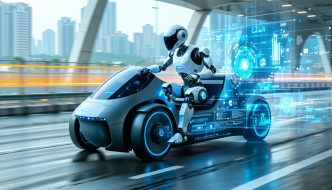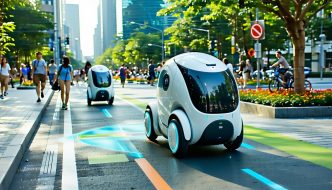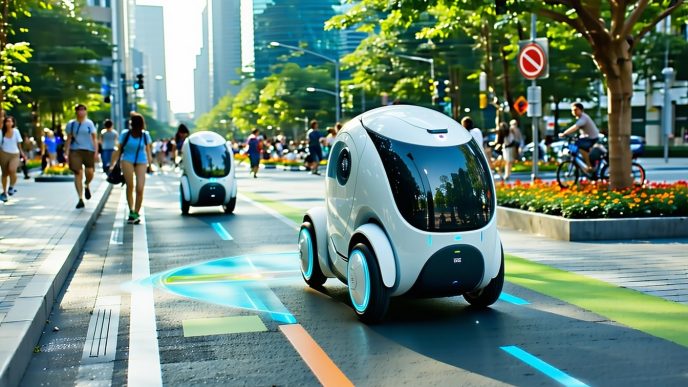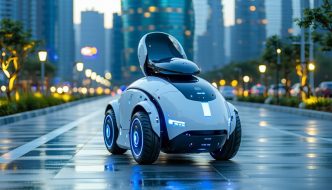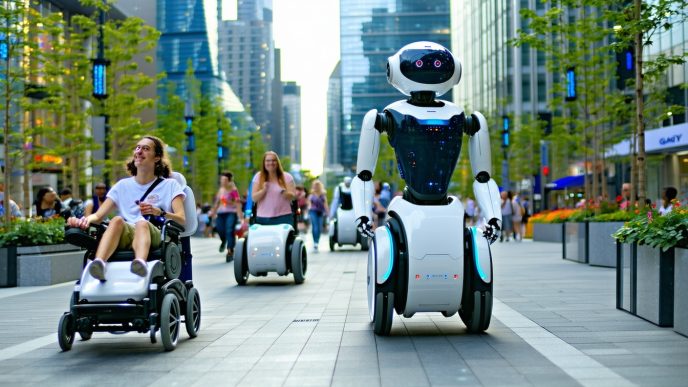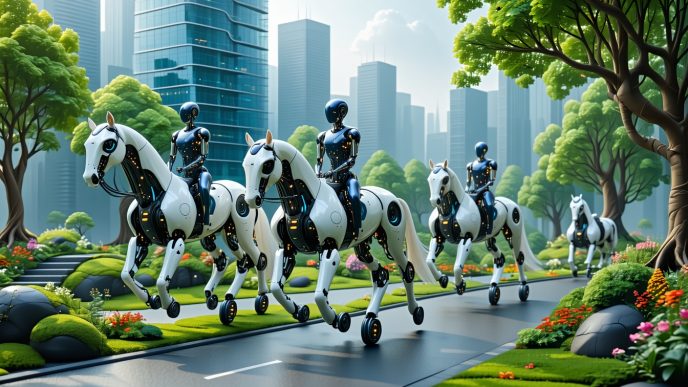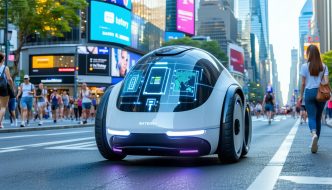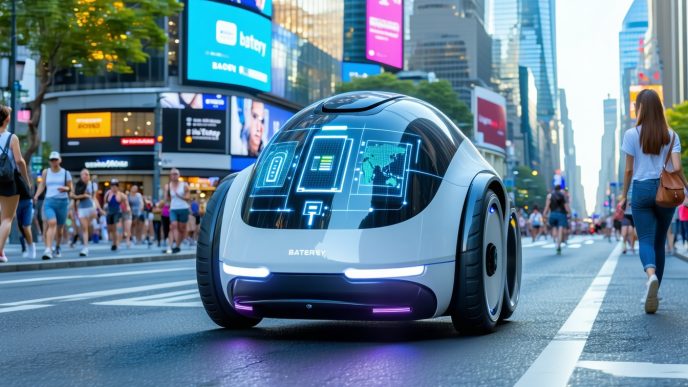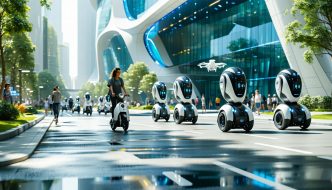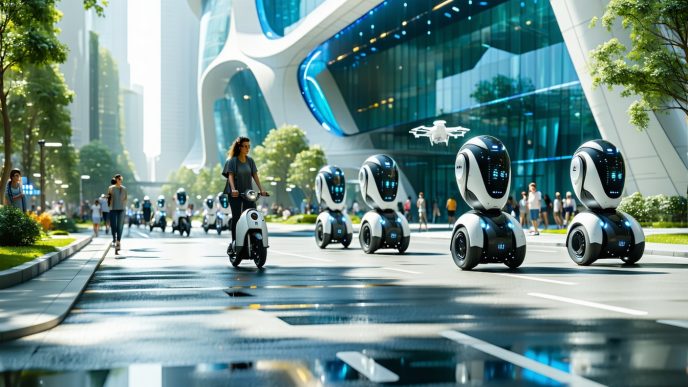Introduction to Rideable Robots
Rideable robots represent a fascinating leap in personal mobility technology. These innovative machines enhance transportation options, especially in urban environments, providing new ways to navigate through crowded spaces with ease and efficiency.
Evolution of Rideable Robots
The development of rideable robots has progressed rapidly over the last few decades. From early prototypes designed for industrial applications to modern electric vehicles and personal transport devices, the journey reflects significant technological advancements.
Initially, rideable robots were limited to specific tasks, primarily in factory settings or controlled environments. However, as technology evolved, the potential applications expanded to include personal transport. Current designs often incorporate advanced features such as smart navigation and adaptive movement capabilities, making them suitable for urban commuting and recreational use.
| Year | Milestone | Description |
|---|---|---|
| 1990s | First prototypes | Basic models for industrial use, limited mobility |
| 2000s | Emergence of personal devices | Introduction of scooters and hoverboards |
| 2010s | Advanced navigation systems | Use of GPS and sensors for improved usability |
| 2020s | Integration with smart technology | Enhanced interfaces and user experience |
Importance of Robot Rider Interfaces
The effectiveness of rideable robots heavily relies on the design of their rider interfaces. These interfaces are crucial in facilitating a seamless connection between the user and the robot, ensuring that the controls are intuitive and responsive.
A well-designed robot rider interface allows users to efficiently control their movements, whether through manual input or automated systems. This user-centric approach is vital for promoting safety and confidence while operating the vehicle. Features might include touchscreens, voice commands, or even gestural controls, catering to various user preferences.
Improving the user experience of robot rider interfaces not only makes them more appealing to early adopters and urban commuters but also enhances their functionality. As more individuals seek innovative solutions for their transportation needs, focusing on effective interfaces will drive the continued evolution of rideable robots. For a deeper dive into the potential applications of these technologies, refer to our article on transportation and rideability robots.
Understanding Robot Rider Interfaces
The interface through which a rider interacts with a rideable robot is crucial for effective control and navigation. This section delves into the basic components and functions of robot rider interfaces and explores how user inputs influence movement.
Basic Components and Functions
Robot rider interfaces are composed of various elements that work together to enable seamless interaction between the rider and the robot. Key components include:
| Component | Function |
|---|---|
| Control Console | Provides the interface for inputting commands and settings. |
| Sensors | Collects data from the environment for navigation and obstacle avoidance. |
| Communication Modules | Enables data exchange between the robot and the user’s device. |
| Feedback Mechanisms | Provides real-time information about the robot’s status, such as speed and battery life. |
| Power Supply | Fuels the robot’s operations and controls. |
These components ensure that riders can effectively manage their robot experiences, making it essential for various applications, including urban commuting and recreation. For more innovative uses of rideable robots, explore our article on transportation and rideability robots.
How User Inputs Control Movement
User inputs play a vital role in dictating how rideable robots move. These inputs can be categorized into several methods:
| Input Method | Description |
|---|---|
| Joystick Control | Allows riders to maneuver their robots with precision by moving a joystick in the desired direction. |
| Touchscreen Interface | Offers a graphical representation of controls, allowing users to tap and swipe for movement commands. |
| Voice Commands | Utilizes voice recognition technology for hands-free operation, enabling users to direct robot actions verbally. |
| Motion Sensors | Detects body movements to control the robot, providing an intuitive riding experience. |
The responsiveness of these input methods can significantly enhance the rider’s experience. Various applications, such as rideable robots for short trips or robot mobility aids for disabled users, can maximize the benefits of these interfaces depending on user preferences and requirements.
In the evolving landscape of personal mobility, understanding the components and communicative aspects of robot rider interfaces will be fundamental in shaping future trends. Discover more about these advancements in our article on the future of rideable robotics.
Types of Control Systems
To effectively control rideable robots, various control systems can be employed, ranging from manual to fully autonomous. Understanding these systems helps to navigate and utilize robot rider interfaces more efficiently.
Manual Control Systems
Manual control systems require the rider to physically control the robot’s movements. This type includes devices where the rider operates levers, buttons, or other physical controls to direct the robot. Manual systems provide immediate feedback and a hands-on experience, allowing the rider to precisely navigate their route.
| Feature | Description |
|---|---|
| Control Method | Physical input from the rider |
| Feedback | Direct and immediate |
| Use Cases | Personal mobility devices, recreational robots |
| User Experience | Engaged rider participation |
Manual control systems are ideal for users who want a strong connection to their ride, granting full oversight of the robot’s actions.
Semi-Autonomous Control Systems
Semi-autonomous control systems blend manual and automated functions. In this setup, the rider has the option to take control while the robot can also make some decisions based on its environment, such as avoiding obstacles or optimizing routes. This adaptability enhances user convenience and safety.
| Feature | Description |
|---|---|
| Control Method | Combination of manual input and automated functions |
| Feedback | Interactive, with both rider and robot input |
| Use Cases | Commute assistive robots, delivery robots |
| User Experience | Flexibility in operation, enhanced security |
Semi-autonomous systems are designed for early adopters looking for a mix of control and innovation in their rideable robots. Users can instantly transition between controlling the robot and allowing it to operate autonomously.
Autonomous Control Systems
Autonomous control systems enable rideable robots to operate independently without any input from the rider. These systems utilize advanced algorithms, sensors, and artificial intelligence to navigate and reach destinations. Riders can set their destination, and the robot will handle the rest.
| Feature | Description |
|---|---|
| Control Method | Fully automated navigation |
| Feedback | Minimal; rider sets the destination |
| Use Cases | Self-driving transportation vehicles, robotic taxis |
| User Experience | Convenient and user-friendly |
Autonomous systems are particularly beneficial for urban commuters seeking effortless travel. With the potential to enhance personal mobility, these systems focus on maximizing efficiency and user ease.
Choosing the right control system plays a significant role in the overall experience of rideable robots. For more insights on how different systems affect mobility innovations, consider reading about transportation and rideability robots.
Navigation Methods
Effective navigation is crucial for the functionality and usability of rideable robots. Various methods are employed to ensure these robots can move safely and efficiently through different environments. This section explores three primary navigation methods: GPS navigation, sensors and obstacle detection, and mapping and route planning.
GPS Navigation
GPS navigation utilizes satellite signals to determine the precise location of a rideable robot. This technology allows for accurate positioning in real-time, enabling users to track their routes effectively.
| Feature | Description |
|---|---|
| Accuracy | Typically within 5 meters |
| Speed | Updates location every second |
| Applications | Urban commuting, outdoor excursions |
GPS navigation works well in open spaces, but its effectiveness can decrease in urban areas with tall buildings or dense structures. Therefore, rideable robots often complement GPS with other navigation methods for better reliability. For insights into the intersection of transportation and robotics, refer to our article on transportation and rideability robots.
Sensors and Obstacle Detection
Sensors play a vital role in helping rideable robots navigate their surroundings. They gather data about the environment, enabling the robot to respond to obstacles, changes in terrain, and other hazards. Common sensors include:
- Lidar: Measures distances using laser pulses to create detailed 3D maps of the environment.
- Cameras: Capture visual data to identify and analyze surrounding objects.
- Ultrasonic Sensors: Use sound waves to measure proximity to nearby objects.
| Sensor Type | Functionality |
|---|---|
| Lidar | 3D mapping and distance measurement |
| Cameras | Object recognition and environmental analysis |
| Ultrasonic | Proximity detection for obstacle avoidance |
These sensors significantly enhance the safety and stability of rideable robots. For more details on safety features, see our article on rideable robot stability and safety.
Mapping and Route Planning
Mapping and route planning technologies allow rideable robots to navigate efficiently from one point to another. By creating a digital map of the environment, these robots can analyze multiple routes and choose the most optimal one based on distance, terrain, and potential obstacles.
Key features of mapping and route planning include:
- Dynamic Routing: Ability to adjust routes in real-time based on current conditions.
- User-Defined Destinations: Users can input desired destinations, and the robot calculates the best route automatically.
- Integration with Traffic Data: Access to live traffic information helps avoid congested areas.
| Feature | Use Case |
|---|---|
| Dynamic Routing | Adapting to road closures or obstacles |
| User-Defined Destinations | Convenience for urban commuting |
| Traffic Data Integration | Minimizing delays and improving efficiency |
These methods collectively enhance the navigation capabilities of rideable robots, making them a practical option for personal mobility. For a glimpse into the future of rideable robotics, explore our article on future of rideable robotics.
Challenges and Innovations
As rideable robots evolve, they face numerous challenges that must be addressed to enhance user experience and functionality. Innovations in technology are helping to overcome these obstacles, leading to advances in robot rider interfaces.
Overcoming Terrain and Environmental Challenges
Riding robots must navigate various terrains and environmental conditions, including rough surfaces, inclines, and obstacles. Efficient navigation systems are crucial for ensuring safety and performance. Innovations such as advanced wheel designs and adaptable suspension systems are being developed to enhance rideability on diverse terrains.
| Terrain Type | Required Features |
|---|---|
| Smooth Pavement | Standard wheels with minimal friction |
| Gravel | Larger wheels with added traction |
| Hills and inclines | Adjustable suspension systems |
| Urban obstacles | Enhanced sensors for detection |
These adaptations not only improve rideability but also expand the range of environments in which rideable robots can be used. For example, robots designed for urban use must navigate crowded landscapes, requiring advanced algorithms for real-time obstacle detection and decision-making.
Enhancing Safety Features
Safety is a top priority for the development of robot rider interfaces. Technologies such as collision avoidance systems, smart braking mechanisms, and stability control have been integrated into rideable robots.
Automated features aimed at enhancing safety include:
- Collision Detection Systems: Using sensors to identify and respond to nearby obstacles.
- Stability Control: Algorithms that adjust the robot’s center of gravity to maintain balance during turns or on uneven surfaces.
- Emergency Braking Systems: Quick-response features that activate if a potential collision is detected.
A summary of safety features in rideable robots is outlined below:
| Safety Feature | Description |
|---|---|
| Collision Warning System | Alerts rider of nearby obstacles |
| Anti-tipping Mechanism | Prevents loss of balance during turns |
| Automatic Shutdown | Stops the robot in case of malfunction |
Improvements in these areas are essential for gaining the trust of users and promoting widespread adoption of rideable robots in urban transport.
Future Developments in Robot Rider Interfaces
Innovations in robot rider interfaces are expected to significantly shape the future of personal mobility. Continued advancements may include:
- Enhanced User Interaction: More intuitive control systems that adapt to individual user preferences and experience levels.
- Integration with Smart Devices: Seamless connectivity with smartphones and wearable technology to provide real-time data and feedback.
- AI-driven Navigation: Implementation of artificial intelligence for enhanced route planning and real-time traffic adjustments.
By prioritizing user feedback, developers are refining robot rider interfaces to better suit the needs of commuters. The ongoing research may lead to more personalized and efficient transport options, transforming personal mobility for various demographics.
For those interested in exploring the intersection between technology and transportation, consider reading our article on robot transportation vs traditional options.
User Experience and Future Implications
The development and integration of robot rider interfaces greatly influence the user experience and shape future mobility trends. By understanding user feedback and the implications of rideable robots, further innovations can be achieved.
User Feedback and Adaptation
User feedback plays a critical role in the evolution of robot rider interfaces. End-users provide insights into their experiences, needs, and preferences, allowing developers to refine features and improve usability. Surveys and testing sessions reveal that comfort, safety, and ease of control are significant factors influencing user satisfaction.
| Feedback Aspect | Importance Level (1-5) |
|---|---|
| Comfort | 5 |
| Safety Features | 4 |
| Ease of Control | 5 |
| Customization Options | 3 |
| Battery Life | 4 |
Developers frequently adapt robot rider interfaces based on this input. For instance, adjusting control sensitivity or enhancing safety protocols creates a more responsive user experience. Understanding user experiences is vital for advancing transportation and rideability robots.
Impact on Personal Mobility Trends
The rise of rideable robots directly affects personal mobility trends. As urban spaces become more congested, individuals seek alternatives to traditional transport options. Rideable robots present environmentally-friendly solutions that reduce reliance on vehicles and promote sustainable commuting methods.
Key trends influenced by robot rider interfaces include:
| Trend | Description |
|---|---|
| Increased Adoption | Higher interest in eco-friendly transport solutions. |
| Shared Mobility | Rise of shared robotic transportation options, reducing individual ownership. |
| Accessibility Enhancements | Development of robots catering to users with mobility challenges, such as robot mobility aids for disabled users. |
| Short Trip Solutions | Popularity of rideable robots tailored for urban commuting, as highlighted in rideable robots for short trips. |
These trends indicate a shift toward embracing technology to enhance everyday transport experiences, impacting both urban infrastructure and user behavior.
Potential for Integration with Smart Cities
Integration with smart city frameworks presents significant opportunities for robot rider interfaces. As cities adopt advanced technologies, rideable robots can seamlessly connect with existing infrastructure, such as traffic management systems and public transportation networks.
Several potential integrations include:
| Integration Aspect | Potential Benefit |
|---|---|
| Traffic Optimization | Rideable robots can contribute to real-time traffic data, optimizing movement patterns. |
| Enhanced Safety | Collaboration between rideable robots and traffic monitoring systems can improve safety measures, addressing rideable robot stability and safety. |
| Energy Management | Charge stations can be implemented in strategic locations to optimize battery range for rideable robots. |
| Innovative Transport Models | Development of comprehensive mobility networks facilitating convenient access to various transportation modes. |
As cities evolve and technology advances, the future of rideable robotics is closely linked to urban planning and design, paving the way for a connected, efficient, and sustainable transportation ecosystem. These developments will significantly shape the future of rideable robotics and their role in daily life.

